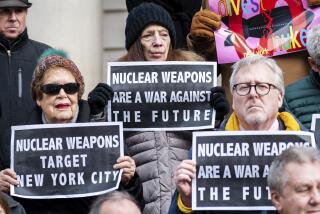Nuclear Reactors Could Get Caught in Power Play
- Share via
WASHINGTON — Already struggling and facing problems with reactor waste, nuclear power may find its biggest challenge still ahead: coping with the electricity industry’s rush toward competition.
Many energy analysts and utility executives believe that commercial nuclear power, once viewed as a source of electricity too cheap to meter, may become one of electricity competition’s casualties--because of its cost.
One recent study suggested that 40% of the country’s nuclear power plants may not be able to compete in the changing marketplace. Other studies have put the number of plants at risk at between 10% and 20%.
Meanwhile, the Nuclear Regulatory Commission has warned the industry not to compromise on safety as competition puts more economic pressures on nuclear plant operators and as ownership of some plants may become muddled.
“Ensuring safety is in no way inconsistent with economic deregulation and competition,” the commission’s chairwoman, Shirley Jackson, told an industry conference in April. But she added that regulators and the industry must “recognize there are no economic shortcuts” to safe nuclear operation.
Nuclear power provides 20% of the country’s electricity, second only to coal.
Industry executives insist that nuclear power is competitive, even in a marketplace where customers can shop around for the cheapest power. On a day-by-day operating basis, they argue, the atom can generate electricity as cheaply as coal or natural gas.
“We are competing on a marginal-cost basis today with any other source of fuel,” said Joe Colvin, president of the Nuclear Energy Institute, the industry’s trade group. In 1995, six of every 10 nuclear power plants generated electricity at less than 2 cents per kilowatt hour, competitive with coal, he added.
But that tells only part of the story, critics say, because marginal costs ignore the huge investments many utilities have made in building nuclear reactors, investments that have yet to be paid off. Nor does it consider tens of billions of dollars it will eventually cost to shut down reactors as they end their license period. Both costs end up on customers’ monthly electricity bills.
Resources Data International, a Boulder, Colo., energy research firm, estimates utilities face $89 billion in past debt from heavily financed nuclear power plants--a cost new competitors do not have.
Nuclear operators say the cost of these past investments should be passed on to all customers, no matter where they buy power, but such recovery is not guaranteed. New Hampshire’s regulators recently directed the state’s utility not to automatically pass on costs of the Seabrook nuclear plant to customers. The utility has challenged the ruling in court.
Some analysts question the survival of dozens of nuclear plants even if the uneconomical investments are recovered.
Eleven of 20 power plants most at risk in a competitive market are “problem nuclear units” with high operating and maintenance costs, said the Resources Data International study. The other nine are coal plants.
More to Read
Inside the business of entertainment
The Wide Shot brings you news, analysis and insights on everything from streaming wars to production — and what it all means for the future.
You may occasionally receive promotional content from the Los Angeles Times.










